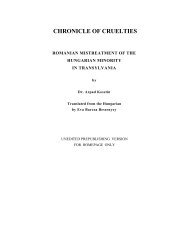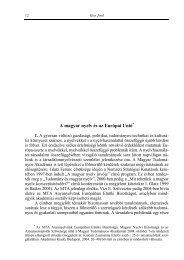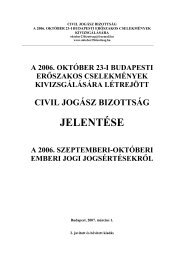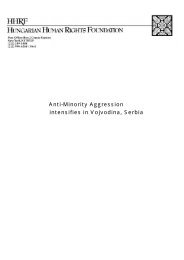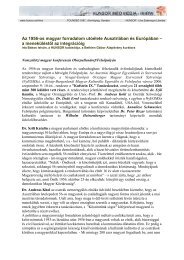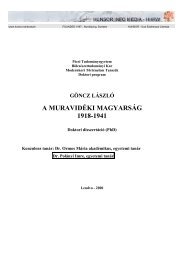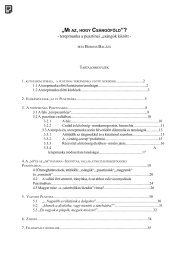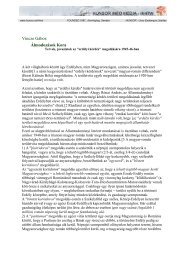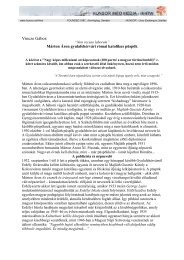PLEASE NOTE: This book contains graphic description ... - HUNSOR
PLEASE NOTE: This book contains graphic description ... - HUNSOR
PLEASE NOTE: This book contains graphic description ... - HUNSOR
Create successful ePaper yourself
Turn your PDF publications into a flip-book with our unique Google optimized e-Paper software.
idge was built (from several rows of logs) and the Russians moved on, milder days hadarrived and there was less potential for slaughter.The prestige and popularity of the Parson was recovered as well.100He had established, during the short Hungarian rule a certain degree of respect in the lower levelof society by setting up a soup kitchen under the aegis of the parish of St Theresa. He did notexclude the needy Serbian families from the benefit of a regular meal. The Hungarian populationof Ada was saved from mortal danger and potential harassment.If we consider the Serb Orthodox clergy's deep rooted animosity and hatred of the HungarianRoman Catholic priests in neighboring villages, the contrast is very clear.MOHOL - DEATH FOR LANDThe agrarian reform of 1920 greatly decreased the landless populace of several thousand in thissmall predominantly Hungarian town. The Serbian paupers were all granted land, while onlythe few Hungarian families that were willing to convert to the Orthodox faith were given thesame benefit.There would have been enough land for the destitute, local Hungarians too, since the authoritiesorganized three farming villages near Mohol for the Serbian settlers from Montenegro or CrnaGora.When the Hungarian army arrived at Mohol in April 1941, the inhabitants of these three Crna-Gorean "Dobrovoljac" settlements, Nyegoshevo, Miltchevo and Svetitchevo were so far fromwanting to shoot at the Hungarian soldiers, that they decorated their lapels with palm size red,white, and green Hungarian rosettes for reasons they deemed appropriate. The Hungariansoldiers returned this amicable and peaceful reception with appropriate friendliness.A few days later, however, the Hungarian gendarmes who replaced the army and began workwere ordered to evacuate the Serbian settlers from their homes, and to put them in a train withtheir scanty luggage. They had to be sent back to their native land via Topolya.The Hungarian paupers of Mohol thought the time had come to satisfy their old hunger for land,and quickly occupied the three deserted settlements. They did so partly for the reason that thelivestock that had been left behind due to the rush had to be fed and watered.The Hungarians from Mohol were to face a shocking disappointment a few days later. Undernew orders, the gendarmes expelled them from their barely warmed abodes with their usualstrictness and firmness and moved them back to their humble hovels at Mohol-Ujtelep. <strong>This</strong>moving in and out involved much more violence than the removal of the Dobrovoljacs with101their Hungarian rosettes. The Hungarian villagers' illegal seizure of land was reversed, becausethe authorities wanted to make room for the Csango-Szekelys coming from Bukovina, Rumania.Nyegoshevo was then inhabited by Szekelys from Istensegits ("God Help"), who christened theirvillage Istenaldasa ("God' Blessing"), on account of their old village and the rich soil.In the course of the next three and a half years, there was much quarreling and violence betweenthe Hungarian poor of Mohol and the Hungarian gendarmerie, or the ruling power in general. As



